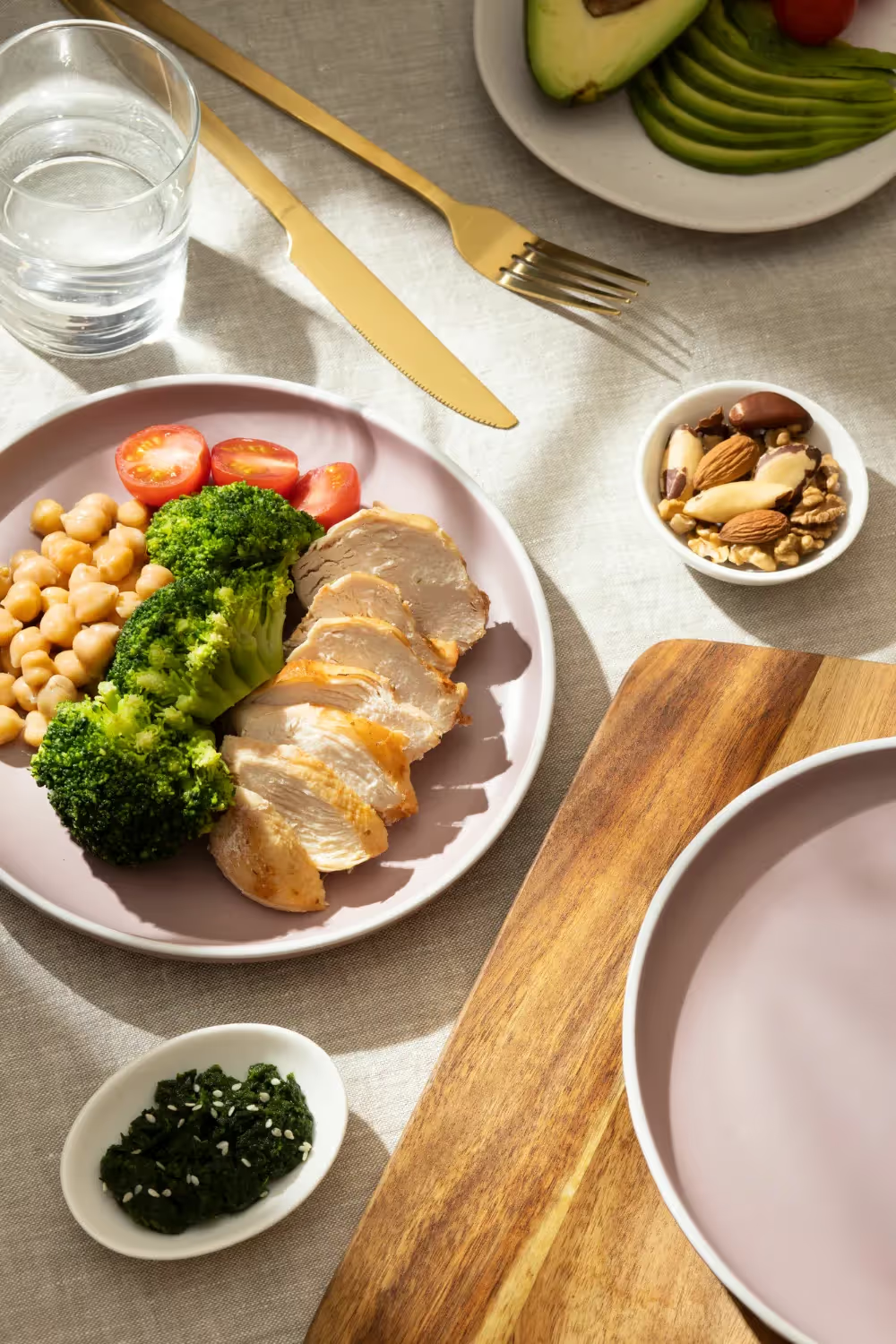Created by Dr. Mary Claire Haver, the Galveston Diet is a science-backed approach that’s aimed at the problems plaguing women in their 40s and beyond: stubborn belly fat, energy crashes, and hormonal weight gain that traditional calorie-counting can't solve.
The Galveston approach combines anti-inflammatory foods, strategic intermittent fasting, and hormone-conscious macros to reduce inflammation, stabilize blood sugar, and support natural fat burning.
If you’re confused about how and where to start this diet, we’ve got everything you need.
The 7-day plan below provides everything, from structured meals to fasting windows and practical tips to reset your metabolism and reclaim your energy during this transitional life stage.
What Is the Galveston Diet and Who Is It For?

Dr. Mary Claire Haver developed the Galveston Diet after recognizing that the traditional "eat less, move more" advice was no longer effective for women in their later years. Between declining estrogen, insulin resistance, and chronic inflammation, women in their 40s need a diet that targets the accumulation of visceral fat and metabolic slowdown, among other things.
The Galveston Diet does just that. How? By focusing on these three core principles:
- 16:8 intermittent fasting
- Anti-inflammatory food choices
- Macro optimization (70% healthy fats, 20% protein, 10% carbs).
This combination makes this diet ideal if you’re struggling with weight plateaus, energy crashes, brain fog, and hormonal symptoms.
7-Day Galveston Diet Plan for Women
Day 1
Eating Window: 12 PM - 8 PM
- Lunch (12 PM): Spinach salad with grilled salmon, avocado, cherry tomatoes, and olive oil dressing
- Snack (3 PM): Handful of almonds with blueberries
- Dinner (6 PM): Lemon garlic chicken with roasted broccoli and cauliflower rice
- Fasting Period: 8 PM - 12 PM the next day (water, herbal tea, black coffee allowed)
Day 2
Eating Window: 11 AM - 7 PM
- Lunch (11 AM): Greek yogurt bowl with chia seeds, raspberries, and chopped walnuts
- Snack (2 PM): Celery sticks with almond butter
- Dinner (5:30 PM): Baked cod with asparagus and mixed greens salad with olive oil
- Fasting Period: 7 PM - 11 AM the next day
Day 3
Eating Window: 12 PM - 8 PM
- Lunch (12 PM): Turkey and avocado lettuce wraps with cucumber slices
- Snack (3 PM): Hard-boiled eggs with everything bagel seasoning
- Dinner (6:30 PM): Grass-fed beef stir-fry with bell peppers, zucchini, and coconut oil
- Fasting Period: 8 PM - 12 PM the next day
Day 4

Eating Window: 11 AM - 7 PM
- Lunch (11 AM): Scrambled eggs with spinach, mushrooms, and feta cheese
- Snack (2:30 PM): Pumpkin seeds and strawberries
- Dinner (6 PM): Grilled shrimp over zucchini noodles with pesto made from basil and pine nuts
- Fasting Period: 7 PM - 11 AM the next day
Day 5
Eating Window: 12 PM - 8 PM
- Lunch (12 PM): Kale and quinoa salad with chickpeas, avocado, and lemon vinaigrette
- Snack (3:30 PM): Cheese slices with cucumber rounds
- Dinner (6:30 PM): Baked chicken thighs with roasted Brussels sprouts and sweet potato (small portion)
- Fasting Period: 8 PM - 12 PM the next day
Day 6
Eating Window: 11 AM - 7 PM
- Lunch (11 AM): Tuna salad (olive oil-based) served over mixed greens with cherry tomatoes
- Snack (2 PM): Macadamia nuts with blueberries
- Dinner (5:30 PM): Pork tenderloin with steamed green beans and cauliflower mash
- Fasting Period: 7 PM - 11 AM the next day
Day 7
Eating Window: 12 PM - 8 PM
- Lunch (12 PM): Vegetable omelet with spinach, bell peppers, and goat cheese
- Snack (3 PM): Avocado slices with sea salt
- Dinner (6 PM): Wild-caught salmon with roasted rainbow vegetables and arugula salad
- Fasting Period: 8 PM - 12 PM the next day
Core Principles of the Galveston Diet
Anti-Inflammatory Eating Explained

The Galveston Diet prioritizes foods that actively reduce chronic inflammation, which, according to studies, is a key driver of menopausal weight gain and metabolic dysfunction.
Chronic inflammation disrupts leptin and ghrelin signaling, making weight loss nearly impossible through calorie restriction alone. Anti-inflammatory foods include omega-3-rich fatty fish, leafy greens, berries, nuts, and olive oil. These are all packed with antioxidants and polyphenols.
Research shows that these nutrients help lower inflammatory markers like C-reactive protein while supporting cellular repair through autophagy.
By reducing systemic inflammation, you’ll enjoy benefits like decreased joint pain, improved energy, better sleep quality, and more efficient fat burning, particularly around the midsection where visceral fat accumulates during hormonal transitions.
Intermittent Fasting and Metabolic Flexibility
The 16:8 intermittent fasting protocol promotes metabolic flexibility by training your body to efficiently switch between glucose and fat as fuel sources.
During the 16-hour fasting window, insulin levels drop, allowing your body to release and burn stored fat as energy. This process becomes increasingly important. In your 40s, your estrogen levels will decline, with hormonal changes leading to insulin resistance and preferential fat storage.
There are studies proving that fasting also triggers autophagy, cellular cleanup that removes damaged proteins and organelles.
During menopause, going through a metabolic reset can help you lose weight consistently, reduce cravings for unhealthy food, and improve your insulin sensitivity. At the same time, having an eating window means that the diet naturally prevents you from starving yourself, which, research has shown, is just as unhealthy as excessive eating.
Fuel Refocus: Tracking Macros, Not Calories
Rather than obsessing over calorie counts, the Galveston Diet emphasizes optimal macronutrient ratios: 70% healthy fats, 20% protein, and 10% carbohydrates.
If it’s familiar, it’s because this high-fat, moderate-protein approach mimics successful ketogenic principles. But what separates the Galveston diet is that it’s more sustainable long-term.
Healthy fats from avocados, nuts, and olive oil provide satiety and support hormone production, including DHEA and testosterone that decline with age. Adequate protein preserves lean muscle mass and supports metabolism, while limiting carbs to nutrient-dense sources, such as vegetables, prevents blood sugar spikes that worsen insulin resistance.
Following this macro distribution leads to more stable energy levels, reduced inflammation, and steady fat loss with minimal metabolic slowdown commonly associated with calorie-restricted diets.
What to Eat and What to Limit
Emphasize eating and stock up on the following foods:
- Wild-caught fatty fish
- Grass-fed meats
- Organic eggs
- Leafy greens
- Cruciferous vegetables
- Berries
- Nuts
- Seeds
- Olive oil
- Avocados
- Fermented foods like kimchi and sauerkraut.
These foods provide essential fatty acids, fiber, antioxidants, and probiotics that support hormone balance and gut health.
Limit your consumption of these foods:
- Refined carbohydrates
- Added sugars
- Processed foods
- Vegetable oils high in omega-6 fats
- Gluten-containing grains
- Alcohol.
These inflammatory foods disrupt blood sugar levels, increase cortisol levels, and exacerbate hormonal imbalances.
How to Maximize Results
Setting Up Your Fasting Window
Start gradually by extending your natural overnight fast by 1-2 hours each day until you reach 16 hours.
Most 12 PM - 8 PM or 11 AM - 7 PM eating windows are most sustainable because it lets you enjoy your lunch, dinner, and snacks while skipping breakfast, allowing you to get up in the morning and start your day faster.
When fasting, stick to water if possible. If you do have to drink something else, drink herbal teas, plain black coffee, or sparkling water. Avoid anything with calories and sugars. These can break your fast. Add ice to your water if you want to feel a different sensation and break the monotony.
Hunger pangs are common at the start. They typically subside within 3-5 days as your body adapts.
However, there’s really no perfect eating window. It all depends on what works best for you. Consistency matters more than perfection.
Hydration, Sleep, and Stress
Proper hydration supports detoxification and helps distinguish between hunger and thirst during periods of fasting. Aim to drink half your body weight in ounces, adding electrolytes if you’re exercising or live somewhere warmer.
Like water, quality sleep is important. It helps with hormone regulation. Poor sleep can disrupt leptin and ghrelin, making weight loss nearly impossible.
For better sleep, create a cooling bedroom environment and limit blue light exposure 2 hours before bed to support melatonin production.
And if possible, find a way to destress yourself throughout the day, preferably before sleeping. Chronic stress elevates cortisol, promoting belly fat storage and insulin resistance. Incorporate stress-reduction techniques like meditation, gentle yoga, or journaling.
Believe it or not, these lifestyle factors often matter more than what you eat, especially when you’re dealing with hormonal fluctuations and metabolic changes.
Meal Prep Tips and Pantry Staples
Dedicate 2-3 hours weekly to preparing proteins, washing vegetables, and portioning healthy fats like nuts and seeds.
To save even more time, cook large batches of compliant proteins, such as grilled chicken, baked salmon, or hard-boiled eggs, which you can easily mix and match on multiple dishes throughout the week.
Pre-cut vegetables stored in glass containers let you maintain their freshness and prevent confusion when whipping up meals on busy days.
Here’s a quick checklist of essential pantry items to stock up on:
- Extra virgin olive oil
- Coconut oil
- Sea salt
- Herbs
- Spices
- Canned wild salmon
- Nuts
- Seeds
- Coconut milk
- Low-sodium bone broth.
Keep frozen organic vegetables and berries on hand for convenient anti-inflammatory additions to any meal when fresh options aren't available.
As a matter of fact, certain studies have shown that frozen vegetables and fruits are healthier because they’re often stored at their peak freshness.
Supplement Support (When Needed)
While whole foods should provide most nutrients, certain supplements can enhance results in your 40s and beyond.
Omega-3 fatty acids (EPA/DHA) support inflammation reduction and brain health, which is especially important as hormonal changes can affect cognitive function. Vitamin D deficiency is a common condition that affects immune function, bone health, and mood regulation. Magnesium supports sleep quality, muscle function, and stress management, as research has proven, helping to alleviate anxiety and sleep disturbances.
Consider probiotics to support gut health and improve nutrient absorption. Like your other organs, your digestive system becomes worse as you age.
However, don’t take supplements blindly. Always consult healthcare providers first, especially if you’re taking medications or managing chronic conditions like thyroid disorders or diabetes.
Adjusting the Plan to Fit Your Hormonal Stage

During Perimenopause
Perimenopause brings unpredictable hormone fluctuations that can intensify cravings, mood swings, and weight gain.
During this phase, focus on stabilizing blood sugar by maintaining consistent meal timing and avoiding skipping meals within your eating window. You may also want to increase your healthy fat intake to 75% of calories to support declining hormone production and reduce anxiety.
As we’ve previously mentioned, magnesium is good for you, so pay special attention to magnesium-rich foods like pumpkin seeds and dark leafy greens to combat increased stress and sleep disruption.
If periods remain irregular, track your symptoms alongside your eating patterns to identify any connections between food choices and hormonal symptoms.
Consider shorter fasting windows (14:10) during particularly stressful weeks or around menstrual cycles when energy demands are higher.
After Menopause
Post-menopause, your body often benefits from stricter carbohydrate limitation since insulin sensitivity gets worse as your estrogen levels drop. Aim for the lower end of the 10% carb recommendation, focusing primarily on fibrous vegetables.
Aside from fat, emphasize protein intake at the higher end (25% of calories) to preserve muscle mass. This is also the time to take more bone-supporting nutrients. Eat more sardines, leafy greens, and consider vitamin K2 sources.
The metabolic flexibility gained from consistent intermittent fasting lets you maintain a healthy weight even as your metabolism slows down.
Don’t be afraid to experiment either. Try extending your fasting windows to 18 hours, or even practicing occasional 24-hour fasts, which, according to this study, may help you lose even more weight and achieve new fitness goals.
If You Have PCOS or Hypothyroidism
If you have PCOS, you’ll want to improve insulin sensitivity and reduce androgen production by including spearmint tea and cinnamon to help balance hormones naturally, and eating inositol-rich foods like cantaloupe and oranges (in small amounts) may support ovarian function.
Individuals with hypothyroidism should get iodine from sea vegetables and selenium from Brazil nuts to support thyroid function.
Regardless of your dietary choices, you need to pay close attention to your energy levels and consider shorter fasting windows. Both PCOS and hypothyroidism affects metabolism, so don’t be too hard on yourself.
The safest way to proceed with the Galveston diet if you have either condition is to work with specialized healthcare providers for closer monitoring.
Recap: What 7 Days on the Galveston Diet Can Do for You
Less Bloating, More Energy
Within the first week, you’ll notice less bloating and digestive discomfort as inflammatory foods are eliminated and gut health improves. The combination of anti-inflammatory foods and intermittent fasting enables the digestive system to rest and repair, thereby reducing gas and abdominal distension that are common during menopause.
After feeling tired and sluggish, your energy levels should stabilize after five days as your blood sugar levels start to improve and your metabolism adjusts to using stored fat for energy.
Don’t be surprised if you’re feeling more alert and energetic during your fasting periods. It’s just your body being able to dedicate more energy to your day-to-day tasks instead of being bogged down by digesting food.
It’s also a side benefit of naturally reducing refined carbohydrates. Unhealthy sugars are typically the cause of afternoon energy slumps.
Better Blood Sugar and Craving Control
The macro composition and fasting protocol work together to improve insulin sensitivity and reduce glucose spikes that drive cravings.
By day 3-4, you’ll start wanting to eat fewer sweets and refined carbs. This is your body adjusting to a whole-foods diet. Don’t worry. You won’t feel hungry. The high-fat content of the diet is designed to keep you satisfied. making it easier to stick to the eating window without feeling deprived.
Because of the added healthy fats, hormonal appetite regulation improves as ghrelin and leptin signaling normalize, leading to natural portion control. Blood sugar stability reduces mood swings and irritability, which are common during your menopausal years.
These improvements in metabolic health create a positive feedback loop, making the eating pattern feel natural rather than restrictive.
Long-Term Next Steps After the 7 Days
Use this week as a foundation to develop sustainable, long-term habits. You don’t necessarily have to follow the same exact diet long-term. You can start with the 16:8 fasting schedule, gradually expanding your approved food list based on how your body responds, before making further adjustments.
As for celebrations, track non-scale victories like improved sleep, reduced joint pain, and increased mental clarity alongside any weight changes.
The Galveston Diet is most effective as a lifestyle approach rather than a quick fix, offering the metabolic flexibility and hormone support that you need during this transitional period in your life.
Sources
- Christensen, Amy, and Christian J. Pike. "Menopause, Obesity and Inflammation: Interactive Risk Factors for Alzheimer’S Disease." Frontiers in Aging Neuroscience, vol. 7, 2015, p. 130, https://doi.org/10.3389/fnagi.2015.00130.
- Chaudhary, Priya, et al. "Oxidative Stress, Free Radicals and Antioxidants: Potential Crosstalk in the Pathophysiology of Human Diseases." Frontiers in Chemistry, vol. 11, 2023, p. 1158198, https://doi.org/10.3389/fchem.2023.1158198.
- Shabkhizan, Roya, et al. "The Beneficial and Adverse Effects of Autophagic Response to Caloric Restriction and Fasting." Advances in Nutrition, vol. 14, no. 5, 2023, p. 1211, https://doi.org/10.1016/j.advnut.2023.07.006.
- Garg, Ruchika; Chetan, Radhika1; Jyothi, G. S.2; Agrawal, Prabhat3; Gupta, Prashant4. Intermittent Fasting and Weight Management at Menopause. Journal of Mid-life Health 16(1):p 14-18, Jan–Mar 2025. | DOI: 10.4103/jmh.jmh_227_24
- Favell, D.J. "A Comparison of the Vitamin C Content of Fresh and Frozen Vegetables." Food Chemistry, vol. 62, no. 1, 1998, pp. 59-64, https://doi.org/10.1016/S0308-8146(97)00165-9.
- Arab, Arman et al. “The Role of Magnesium in Sleep Health: a Systematic Review of Available Literature.” Biological trace element research vol. 201,1 (2023): 121-128. doi:10.1007/s12011-022-03162-1
- Cienfuegos, Sofia, et al. "Changes in Body Weight and Metabolic Risk during Time Restricted Feeding in Premenopausal versus Postmenopausal Women." Experimental Gerontology, vol. 154, 2021, p. 111545, https://doi.org/10.1016/j.exger.2021.111545.
FAQs
What is the Galveston Diet and why is it for women over 40?
The Galveston Diet is an anti-inflammatory eating approach created by an OB/GYN specifically to combat the hormonal changes that cause weight gain and inflammation during perimenopause and menopause. It focuses on nutrient-dense foods and incorporates intermittent fasting to help rebalance hormones and improve insulin sensitivity.
What kind of foods are included in this 7-day plan?
This plan centers on anti-inflammatory foods. You'll eat plenty of lean protein (like chicken and salmon), healthy fats (avocado, nuts, olive oil), non-starchy vegetables (leafy greens, broccoli), and low-sugar fruits (berries). The plan eliminates inflammatory foods like processed items, added sugars, and artificial ingredients.
Do I have to do intermittent fasting on this plan?
Yes, intermittent fasting is a core component of the Galveston Diet. Our 7-day plan guides you through a common 16:8 schedule, where you fast for 16 hours and eat during an 8-hour window. This is designed to reduce inflammation and help your body burn fat more effectively. We provide a simple schedule to make it easy to follow.
What results can I expect after just 7 days?
While some weight loss can occur, the primary goal of the first 7 days is to reduce inflammation and reset your metabolism. Most women report feeling significantly less bloated, having more energy, and experiencing better mental clarity. This plan is the foundation for sustainable, long-term hormonal balance and weight management.
Is this diet sustainable long-term, or just a 7-day fix?
The 7-day plan is designed as a structured introduction to a new lifestyle. The principles of the Galveston Diet—focusing on anti-inflammatory whole foods and intermittent fasting—are intended to be a sustainable, long-term way of eating that you can adapt to your life well beyond the first week.















